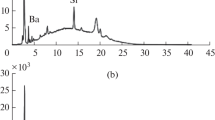Abstract
The use of the antibiotic agent tetracycline for analytical purposes in solvent extraction procedures is presented. Individual extraction curves for the lanthanides, zinc, scandium, uranium, thorium, neptunium and protactinium were obtained. Separation of those elements one from another, and of uranium from selenium, bromine, antimony, barium, tantalum and tungsten was carried out. In all cases benzyl alcohol was the diluent used to dissolve tetracycline hydrochloride. Sodium chloride was used as supporting electrolyte for the lanthanide separations and sodium perchlorate for the other elements mentioned. Stability or formation constants for the lanthanide complexes as well as for thorium complex with tetracycline were determined by using the methods of average number of ligands, the limiting value (for thorium), the two parameters and the weighted least squares. For the lanthanides, the stability constants of the complexes Ln(TC)3 go from 9.35±0.22 for lanthanum up to 10.84±0.11 for lutetium. For the Th(TC)4 complex the formation constant is equal to 24.6±0.3. Radioisotopes of the respective elements were used for the determinations. When more than one radioelement was present in an experiment, a multichannel analyser coupled to Ge(Li) or NaI(Tl) detectors was used for counting the activities. When only one radioisotope was used, counting of the radioisotopes was made with a single-channel analyser (integral mode counting) coupled to a NaI(Tl) detector. Uranium was determined by activation analysis (epithermal neutrons). Radioisotopes of the elements were obtained by irradiation in the IPEN swimming-pool reactor. The natural radioisotope2 3 4Th was used as label in the thorium experiments. In some separation procedures such as in the case of the pair uranium-neptunium, and of the pair scandium-zinc, the separation was obtained by properly adjusting the pH value of the aqueous phases, before the extraction operation. In other cases, addition of masking agents to the extraction system was required in order to perform the separation between the elements under study. In this way ethylenediaminetetraacetic acid (EDTA) was used as masking agent for scandium and the lanthanides in order to allow separation of uranium from those elements. Diethylenetriaminepentaacetic acid (DTPA) was used as masking agent for thorium in order to extract uranium into the organic phase. Separations of protactinium from thorium, and of uranium from protactinium and thorium, were accomplished by using sodium fluoride as masking agent for protactinium and DPTA as masking agent for thorium and protactinium at the same time. In the case of the separation of the lanthanides one from another it is necessary to resort to a multi-stage extraction procedure since the stability constants for those elements are too close.
Similar content being viewed by others
References
M. ISHIDATE, T. SAKAGUCHI, Pharm. Bull., 3 (1955) 147.
A. A. ASHTON, Anal. Chim. Acta, 35 (1966) 543.
L. W. MASTERS, Master of Sciences Thesis, American University Washington, D. C., June 1968.
L. W. MASTERS, NBS Technical Note 508 Activation Analysis Section, July 1970.
A. ALBERT, Nature, 172 (1953) 201.
A. ALBERT, C. W. REES, Nature, 177 (1956) 433.
D. C. MAXWELL, P. J. A. SMITH, S. P. WILFORD, Nature, 198 (1963) 577.
M. J. C. NASTASI, Doctor’s Thesis, Instituto de Quimica, University of São Paulo, Publication IEA—Dissertations and Thesis Series—IEA No 45, 1978 (In Portuguese).
M. J. C. NASTASI, F. W. LIMA, Radiochem. Radioanal. Letters, 29 (1977) 61.
M. SAIKI, F. W. LIMA, Radiochem. Radioanal. Letters, 35 (1978) 63.
M. SAIKI, F. W. LIMA, J. Radioanal. Chem., 36 (1977) 435.
M. SAIKI, F. W. LIMA, J. Radioanal. Chem., 50 (1979) 77.
M. SAIKI, F. W. LIMA, Radiochem. Radioanal. Letters, 35 (1978) 53.
M. SAIKI, F. W. LIMA, Radiochem. Radioanal. Letters, 29 (1977) 67.
M. SAIKI, F. W. LIMA, Radiochem. Radioanal. Letters, 30 (1977) 1.
P. FIELDS, The Transuranium Elements, Research Papers, Paper 15. 10. NNES-IV, 14-B. Part II G. T. SEABORG, J. J. KATZ, W. M. MANNING (Eds), McGraw Hill Book Co., Inc. New York, 1949.
A. ABRÃO, Chromatographic Separation and Concentration of Thorium and Rare Earths from Uranium, Using Alumina-Hydrofluoric Acid. Preparation of Carrier-Free Radio-Thorium. Sao Paulo, Brasil, Instituto de Energia Atômica, 1970 (IEA-Pub-217).
K. K. KRAUSS, G. E. MOORE, F. NELSON, J. Am. Chem. Soc., 78 (1956) 2692.
L. T. ATALLA, F. W. LIMA, J. Radioanal. Chem., 20 (1974) 607.
V. V. NALIMOV, The Application of Mathematical Statistics to Chemical Analysis, Pergamon Press, Oxford, 1963.
J. STARY, The Solvent Extraction of Metal Chelates, Pergamon Press, Oxford, 1964.
J. RYDBERG, Arkiv for Kemi, 8 (1953) 101.
W. A. BAKER, Jr., P. M. BROWN, J. Am. Chem. Soc., 88 (1966) 1314.
D. E. WILLIAMSON, G. W. EVERETT Jr., J. Am. Chem. Soc., 97 (1975) 2397.
J. C. SULLIVAN, J. RYDBERG, W. F. MILLER, Acta Chem. Scand., 13 (1959) 2023.
L. C. CRAIG, D. CRAIG, Technique of Organic Chemistry, A. WEISSBERGER (Ed.) Vol. 3, Part I, 2nd ed., Intersciencem New York, 1956.
W. B. BROWN, G. W. POPE, J. F. STEINBACK, W. F. WAGNER, J. Inorg. Nucl. Chem., 25 (1963) 429.
L. G. SILLEN, A. E. MARTELL, Stability Constants of Metal-Ion Complexes. Special Publication No. 17. The Chemical Society, Burlington House W.1., London, 1964.
Author information
Authors and Affiliations
Rights and permissions
About this article
Cite this article
Saiki, M., Nastasi, M.J.C. & Lima, F.W. Use of tetracycline as complexing agent in radiochemical separations. J. Radioanal. Chem. 64, 83–116 (1981). https://doi.org/10.1007/BF02518344
Received:
Issue Date:
DOI: https://doi.org/10.1007/BF02518344



